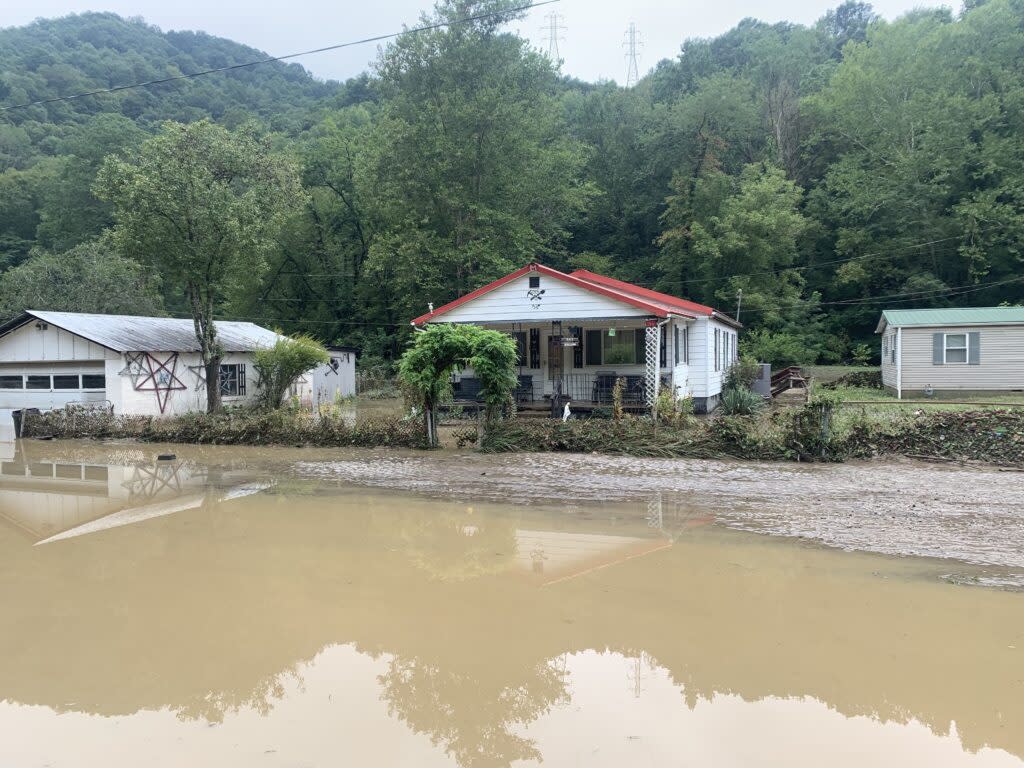Congress should take proactive steps to address flooding in West Virginia and Appalachia

Flooding at Fields Creek Road in Winifrede, W.Va. on Tuesday, Aug. 29, 2023. (Lori Kersey | West Virginia Watch)
Since 2013, the federal government has declared more than 20 flooding disasters across Central Appalachia — including nine in West Virginia alone. At least 230 lives were lost in these disasters in the region, and the Federal Emergency Management Agency spent nearly $1 billion in recovery efforts to pick up the pieces.
In addition to the floods that were declared disasters, West Virginia experienced nearly 400 flash floods over the last five years. We’re just six months into 2024 and West Virginia has already seen several powerful floods, including one that covered the interstate in Charleston and another that washed out a cemetery in Wheeling. Needless to say, now every time it rains, many lie awake worrying about whether or not they, their loved ones, their homes and their businesses will be safe from flooding.
Appalachians are tired of worrying — and they’re taking action. A diverse coalition of nearly 60 organizations from across the region have united to implore Congress to offer federal solutions to their harrowing flood challenges — challenges that the small former coal towns and rural communities are simply not equipped to handle on their own.
Appalachia’s landscape and history of natural resource extraction have made its communities uniquely vulnerable to flooding. Human activity on the landscape — especially from coal mining, logging, and road and home construction — has impacted the region in disparate ways.
In addition, the land’s topography, with its rolling hills and mountains, means people often live on flat land located near rivers or streams. Other risk factors include historic lack of investment in rural Appalachian communities, resulting in less accurate flood maps and fewer early warning systems for rising water levels, as well as limited response and recovery resources when disasters hit. West Virginia faces one of the highest flood risks, according to First Street Foundation, a nonprofit climate data modeler. Their data shows that the federal government’s risk maps that we rely on are out of date.
Also, keep in mind that nearly 30 percent of land in Appalachia is devoted to agriculture. Flooding affects all members of a community, but farms take a double hit with crop losses and soil loss, plus other infrastructure damage. Small farms are particularly vulnerable, and Appalachia is characterized by small-scale farming. The average farm size in the region is 147 acres, in comparison to the national average of 441 acres.
There is good news, however. In a world where few issues are bipartisan, investing in flood resilience should be a no brainer for lawmakers regardless of party or ideology. A recent report from Congress’ bipartisan Joint Economic Committee found that every dollar invested in flood protection saves up to $318 in damages, and adaptation measures can prevent job losses and increase employment growth.
The Appalachian coalition is encouraging Congress, particularly West Virginia’s delegation, to increase flood resilience by taking action on a number of fronts. To begin, Congress should make certain changes to the Farm Bill, which is currently under discussion in the House and Senate. Changes proposed by the coalition focus on sustainable land management, conservation efforts, and infrastructure improvements to help farms and communities better withstand flooding.
The problems created by flooding hit all aspects of our lives, and the solutions need to be equally ambitious and far reaching. The best approach is to prevent the worst impacts of flooding through mitigation efforts, but we also need to be better prepared to help communities more quickly bounce back from extreme weather events. The coalition is asking Congress to address these complex needs with four main pillars, including 1) increasing local and state capacity to respond and recover, 2) relieving the recovery and mitigation burden for low-income households, 3) improving flood mapping and data inputs, and 4) investing in nature-based hazard mitigation.
Furthermore, in order to maximize benefits for Appalachian communities, implementation of these pillars should include strong labor standards such as local hiring, and the use of regionally sourced materials where applicable.
The diverse roster of the Appalachian coalition proves that enacting these policies shouldn’t be a political matter, but simply a matter of the government meeting its mandate to protect the American people. Because the fact remains that there are still victims from past flood events who have been unable to repair their homes and who continue to live in temporary housing. Why is more not being done to help them?
As we can see from increased flooding over the past ten years, the question is not whether the next flood will take place, but when. And before it does, our lawmakers must act.
GET THE MORNING HEADLINES DELIVERED TO YOUR INBOX
The post Congress should take proactive steps to address flooding in West Virginia and Appalachia appeared first on West Virginia Watch.

